新加坡文化 singapore language
新加坡文化传统英语

新加坡文化传统英语Singapore is a melting pot of cultures, and this is reflected in the unique blend of languages and traditions that can be found in the country. One of the most prominent cultural influences in Singapore is the use of English as a common language.English has been a part of Singapore's cultural fabric for many years, dating back to the colonial era when the British ruled the island. Over time, English has become the language of business, education, and government in Singapore, and is spoken by peopleof all ethnicities and backgrounds.However, the use of English in Singapore is not just a reflection of the country's colonial past. It also represents the country's commitment to being a global hub for trade, finance, and tourism. English is seen as a unifying language that allows people from different cultural and linguistic backgrounds to communicate effectively with one another.In addition to English, Singapore is also home to a rich tapestry of languages and dialects, including Mandarin, Malay, Tamil, and various Chinese dialects. This linguistic diversity is a testament to the country's multicultural heritage and is celebrated through the use of these languages in everyday life.One of the most unique aspects of Singapore's linguistic landscape is the use of Singlish, a colloquial form of English that incorporates words and phrases from various languages spoken in Singapore. Singlish is a reflection of the country's multicultural identity and is often used as a way for Singaporeans to connect with one another on a deeper level.In terms of traditions, Singapore's cultural diversity is also evident in the various festivals and celebrations that take place throughout the year. From Chinese New Year to Hari Raya, Deepavali, and Christmas, Singaporeans from all walks of life come together to celebrate these important occasions, often in a spirit of unity and harmony.Overall, Singapore's cultural traditions and the use of English as a common language are a testament to the country's multicultural identity and its commitment to embracingdiversity. This unique blend of languages and traditions is what makes Singapore a truly special place, and it is something that should be celebrated and cherished for generations to come.。
新加坡的风俗习惯有哪些
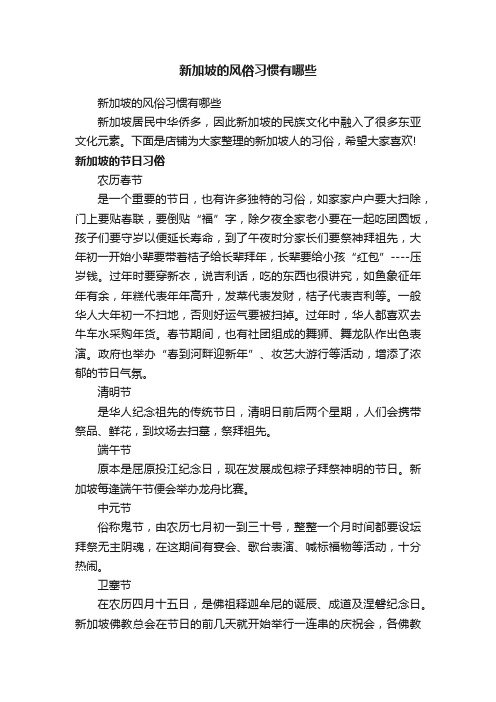
新加坡的风俗习惯有哪些新加坡的风俗习惯有哪些新加坡居民中华侨多,因此新加坡的民族文化中融入了很多东亚文化元素。
下面是店铺为大家整理的新加坡人的习俗,希望大家喜欢! 新加坡的节日习俗农历春节是一个重要的节日,也有许多独特的习俗,如家家户户要大扫除,门上要贴春联,要倒贴“福”字,除夕夜全家老小要在一起吃团圆饭,孩子们要守岁以便延长寿命,到了午夜时分家长们要祭神拜祖先,大年初一开始小辈要带着桔子给长辈拜年,长辈要给小孩“红包”----压岁钱。
过年时要穿新衣,说吉利话,吃的东西也很讲究,如鱼象征年年有余,年糕代表年年高升,发菜代表发财,桔子代表吉利等。
一般华人大年初一不扫地,否则好运气要被扫掉。
过年时,华人都喜欢去牛车水采购年货。
春节期间,也有社团组成的舞狮、舞龙队作出色表演。
政府也举办“春到河畔迎新年”、妆艺大游行等活动,增添了浓郁的节日气氛。
清明节是华人纪念祖先的传统节日,清明日前后两个星期,人们会携带祭品、鲜花,到坟场去扫墓,祭拜祖先。
端午节原本是屈原投江纪念日,现在发展成包粽子拜祭神明的节日。
新加坡每逢端午节便会举办龙舟比赛。
中元节俗称鬼节,由农历七月初一到三十号,整整一个月时间都要设坛拜祭无主阴魂,在这期间有宴会、歌台表演、喊标福物等活动,十分热闹。
卫塞节在农历四月十五日,是佛祖释迦牟尼的诞辰、成道及涅磐纪念日。
新加坡佛教总会在节日的前几天就开始举行一连串的庆祝会,各佛教团体及寺庙张灯结彩,大放光明,象征佛陀的光辉世世代代照耀人间。
国庆日(NATIONAL DAY )8月9日是新加坡的国庆日(National Day),这是纪念 1965年新加坡独立的日子。
这一天全国人民会聚在一起,用声势浩大壮观的游行、集体舞蹈和大型烟花表演来庆祝这一日子开斋节马来人最重要的节日当属开斋节,每年回历九月,回教徒从日出到日落都要禁食,戒食一个月后见到新月才可开斋,回教徒会把家里打扫干净,装饰一番,穿上新缝的传统服装,备好各式美食糕点来庆祝开斋节,其热闹气氛与华人的春节不相上下。
新加坡: 本地华语丰富了“大华语”

新加坡:本地华语丰富了“大华语”新加坡是一个多元文化的国家,拥有四种官方语言,分别是英语、马来语、华语和泰米尔语。
华语作为华人社群的主要语言,在新加坡有着广泛的使用和影响。
新加坡的华语是一个独特且丰富的语言体系,被称为“新加坡华语”或“大华语”。
它是在华人和其他族群的交流中所形成的,融合了各种方言和语言的元素,包括广东话、福建话、客家话、潮州话等。
这种混杂的语言形式使得新加坡华语具有独特的特点和风格。
它不同于中国大陆的普通话,也有别于台湾的国语。
新加坡华语在词汇、发音和语法上都有自己的特色。
举例来说,新加坡华语中经常使用一些来自于各个方言的词汇,例如“lah”、“leh”、“loh”等。
这些词语在正式的普通话中是不存在的,在新加坡华语中却成为了常用的口语表达。
在新加坡,华语与其他语言也产生了很多交流和影响。
尤其是英语,作为新加坡的官方语言之一,为华语提供了很多的借用词汇。
这些借词既可以是英语直接翻译过来的,也可以是根据英语单词的发音进行的创造。
这使得新加坡华语与英语之间形成了一种独特的互动和融合,丰富了华语词汇的多样性。
为了适应当地社会和文化的需求,新加坡华语也发展出了一些专门的词汇和用法。
在饮食方面,新加坡华语中出现了一些特别的词语,如“炒粿条”(Char Kway Teow)和“烧腊”(Roast Meat)。
这些词语在中国大陆和台湾可能并不常见,但在新加坡的华语中却非常常见。
新加坡的本地华语丰富了“大华语”,在词汇、发音和用法上有着独特的特点。
它不仅仅是华人社群内部的交流工具,也在国际舞台上发挥着重要的作用。
通过融合各种方言和语言,新加坡华语成为一种独特而充满活力的语言形式,展现了新加坡多元文化的魅力。
新加坡的多元文化(1)

仪态礼仪
新加坡人举止文明,处处体现着对他人的尊重。
他们坐着时,端正规矩,不将双脚分开,如果交叉双脚,只是 把一只腿的膝盖直接叠在另一只腿的膝盖上。
他们站立时,体态端正,而不把双手放在臀部,因为那是发怒 的表现。
禁忌
1、忌4、7、13、37、69。
2、不喜欢乌龟。
3、严禁放烟花鞭炮。
4、不准嚼口香糖,过马路时不能闯红灯, 在公共场合不准吸烟、吐痰和
新加坡的多元文化
新加坡(Singapore )
狮城 岛国 马六甲海峡 花园城市 发达国家 华人众多 亚洲四小龙 李光耀 ……
CONTENTS
01 Part One 概况
“狮城”的由来
新加坡的原意为“狮城”。据 马来史籍记载,公元1324年左 右,苏门答腊的一个王子乘船 到达此岛,在现今的新加坡河 口无意中发现一头动物形若狮 子,于是把这座小岛取名 Singapura。“Singa“就是 狮子的意思,“Pura”则代表 城市,而狮子具有勇猛、雄健 的特征,故以此作为地名,这 就是新加坡 “狮城” 的来历 。
随地乱扔废弃物品。
宗教
新加坡是一个多元民族、多元文化的移民社会,当中有宗教信仰的新 加坡人占全国人口的83%。新加坡提倡宗教与族群之间的互相容忍和 包容精神,实行宗教自由政策,确认新加坡为多宗教国。
马来人和巴基斯坦人多信奉伊斯兰教,华人及斯里兰卡人多信奉佛教 ;此外,还有人信奉基督教。
主要宗教:佛教、道教 、伊斯兰教、天主教、基督教 与其他宗教 。
餐饮礼仪
新加坡人的主食多是 米饭,有时也吃包子 等,但不喜食馒头.
新加坡最具代表性的菜是 “娘惹食物”(The Blue Ginger Restaurant),它是最 特别、最精致的传统佳肴 之一。
新加坡风俗习惯及文化特色介绍

新加坡风俗习惯及文化特色介绍新加坡的华人主要来自广东、福建、上海和海南等地。
新加坡籍商人一向有勤奋、诚实、谦虚、可靠的美德。
与新加坡人谈判,不仅必须以诚相待,更重要的是考虑给对方面子,不妨多说几句“多多指教”、“多多关照”的谦言。
值得一提的是,与海外华人进行贸易,采用方言洽谈,有时可以起到一种独特的作用。
碰上说潮州话的商人,首先献上一句“自己人,莫客气”的潮州乡音,给人一种宾至如归的感觉,其他象粤语、滇语等同样有助于谈判的进行和成功。
在新加坡,进清真寺要脱鞋。
在一些人家里,进屋也要脱鞋。
由于过去受英国的影响,新加坡已经西方化。
但当地人仍然保留了许多民族的传统习惯,所以打招呼的方式都各有不同,最通常的是人们见面时握手,对于东方人可以轻轻鞠一躬。
新加坡人接待客人一般是请客人吃午饭或晚饭。
和新加坡的印度人或马来人吃饭时,注意不要用左手。
到新加坡人家里吃饭,可以带一束鲜花或一盒巧克力作为礼物。
谈话时,避免谈论政治和宗教。
可以谈谈旅行见闻,你所去过的国家以及新加坡的经济成就。
由于新加坡居民中华侨多,人们对色彩想象力很强,一般对红、绿、蓝色很受欢迎,视紫色、黑色为不吉利,黑、白、黄为禁忌色。
在商业上反对使用如来佛的形态和侧面像。
在标志上,禁止使用宗教词句和象征性标志。
喜欢红双喜、大象、蝙蝠图案。
数字禁忌4、7、8、13、37和69.新加坡独立前,四面野草丛生,蚊蝇遍地。
26年后的今天,被誉为“美丽的花园城市”。
旅游业十分发达,每年到这里观光的游客达四五百万。
在高层建筑物之间,都留有较大的空地布置绿化,设有花架、花坛,并广植花草。
因此,市区地面除了柏油马路和铺砖的便道以外,均以花草木覆盖,可以说做到了“黄土不见天”。
北京商务旅游品牌服务提示新加坡除了园林绿化举世瞩目外,城市环境卫生也很出色,空气清新宜人。
市内街道非常清洁,马路上根本看不到垃圾,就连建筑物上也极干净,确是一尘不染。
街头严禁乱扔烟头及杂物,乱扔纸屑、烟头罚500新加坡元。
新加坡

新加坡英语(Singlish/Singaporean)是一种英语方言,通用于新加坡,主要受到英国英语影响,但最近日益受到美国英语的影响。
此外很多的词汇、语法也借自福建话、广东话、普通话和马来语,有克里奥耳语(混合语)的特征。
新加坡英语的发音也很独特。
简单地说,新加坡英语就是:英文词汇+混合语法+以中文为主体的语气和语调。
Singlish是什么?相信在新加坡呆过一段时间的人都应该知道。
Singlish = Singapore English。
Singlish的特点是普通英语和我们相声小品中的夸张的粤语系普通话的合体,英语大家都知道是什么,什么是夸张的粤语系普通话?呵呵,这是我以偏概全的理解,夸张的粤语系普通话就是在每句话的结尾都加上一个―啦‖,或者―啊‖,其前的相声小品中经常会把一些中国内地的人士(非粤语系)描绘成讲着这种夸张的粤语系普通话的样子,让人忍俊不禁。
新加坡人讲Singlish似乎无可厚非,我对此也是没有异议(即使有异议,似乎也没什么用),我今天向说一说关于非新加坡人士如何看待Singlish这种语言的。
首先,我不会把Singlish作为English的变种,因为就其本身似乎已经变成了两种语言,虽然差距还没有法语、意大利语、西班牙语和葡萄牙语的差别大(法语、意大利语、西班牙语和葡萄牙语都有拉丁语的血统,都属于拉丁语系),如果我们一定要把某种英语作为正宗的话,那应该是Angles(英语的雏形),不然的话,把任何一种英文的变种(美式英语,澳式英语或者是Singlish)作为英式英语的变种,都和把法语或者德语作为拉丁语的变种一样,只会让人笑话。
关于Singlish,我想要说说社会问题和经济问题。
很多人来到了新加坡,都会潜移默化的,不知不觉的学会讲Singlish,起码是某些词汇(例如,Wah Lau等),这是一个社会化的过程,是一个本土化的过程,比较恰当的类比是在America只卖Burgers,Fries,和Coca Cola 的McDonald‗s到了中国就变成了卖汉堡包和炸薯条还有可口可乐的麦当劳,不仅如此,还要卖一些诸如翡翠汤的食物(这个细节我还没有考证,仅仅知道有这些东西,但都没吃过,都回家了,谁还吃麦当劳啊)。
新加坡文化
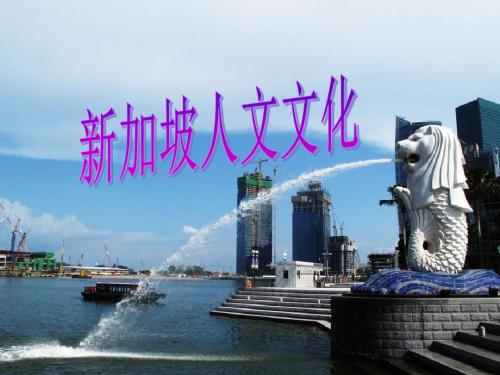
Ⅲ.相见礼仪
在社交场合,新加坡人与客人相见时, 一般都施握手礼。男女之间可以握手, 但对男子来说,比较恰当的方式是等妇 女先伸出手来,再行握手。马来人则是 先用双手互相接触,再把手收回放到自 己胸部。
ห้องสมุดไป่ตู้
Ⅳ.餐饮礼仪
新加坡人的主食多是米饭,有时也吃包 子等,但不喜食馒头。 马来人用餐一般用手抓取食物,他们在 用餐前有洗手的习惯,进餐时必须使用 右手。饮茶是当地人的普遍爱好,客人 来时,他们常以茶水招待,华人喜欢饮 元宝茶,意为财运亨通。
一些国家给小费的情况:
日本:进入饭店门前只须向女服务员付小费即可。
泰国:对象无论男女必须付小费。
新加坡:付小费是被禁止的,因为付小费是说明服务质量 差。
瑞士:付小费是不公开的,但出租车明文规定收取车费 10%的小费。
法国:公开的,不能低于总价款的10%,服务员的小费计 算入财政税收中。
意大利:不公开但要给。
北非中东地区是必须要给小费的,若没有给,可追上去索 取,是老人和小孩的生活费用。
*禁忌
新加坡人忌7字。
不喜欢乌龟。 严禁放烟花鞭炮。
EDUCATION教育
新加坡教育制度类似英国式制度,除了各语文类 科外,均以英语为媒介语言。一般修读完十到十一 年的中小学后能选择到初级学院、高中或理工学院 就读,前两者半数以上能升上国内大学。新加坡有 五所理工学院与三所大专学府,其中新加坡国立大 学与南洋理工大学都是亚洲颇具盛名的学府。 新加坡每年吸引不少来自中国各地区和马来西亚等 地的留学生前来升学,令该国成为亚洲的区域教育 枢纽。 新加坡教育制度采用双语教育的教学方法,让学 生学到如何使用英语与不同种族、不同宗教人群交 流增加社会和谐度,也可以用母语与自己同种族、 同宗教的人进行交流,使他们的历史文化可以持续 下去。
新加坡官方语言主要是什么?

新加坡官方语言主要是什么?每一个国家都有属于自己的官方语言,就比如中国的第一语言就是汉语,我们通用的普通话,但是在国际上面的交流自然用到的是英语。
其他的国家都有属于自己的语言,所以什么样的国家,通过语言就可以很好的判断出来。
新加坡是一个多语言的国家,所以新加坡官方语言是什么还是要看看新加坡的历史是怎么样进行发展的。
新加坡官方语言新加坡的官方语言主要有四种,分别是马来西亚语、英语、汉语以及泰米尔语。
为什么会有马来西亚语,是因为新加坡在没独立之前,这个国家是属于马来西亚的。
所以在新加坡的宪法当中,可以清楚的了解到马来西亚语是作为新加坡的国语的。
但是本国内在的语言使用却不止这一种,所以你比较擅长什么样的语言,就可以很好的进行交流。
本网注明“来源:新加坡主要语言”的所有作品,版权均属于居外,未经本网授权不得转载、摘编或利用其新加坡官方语言关于新加坡的英语语言的使用,是因为在国际上面,英语的使用是广泛的,国际上面的通用语言。
所以在进行国际交流或是其他的方式时,都会运用英语来进行交流。
所以英语对于新加坡来说是第一语言,运营上的广泛性是比较强的。
其实不仅仅是在新加坡,任何国家在国际上面进行交流的时候,都是通过英语来进行的,所以学好英语是有好处的。
本网注明“来源:新加坡主要语言”的所有作品,版权均属于居外,未经本网授权不得转载、摘编或利用其新加坡官方语言最后就是汉语,中国的语言为什么在新加坡的使用如此广泛呢?其实这个也是有一定的原因的,新加坡的发展的过程中,有一半以上的人群都是华人,大部分都是广东,福建等这些地方过去的人,在汉语语言上他们对于客家话方言也是会的,自然中文普通话也是会的。
话语作为母语成为华人之间通用的语言。
本网注明“来源:新加坡主要语言”的所有作品,版权均属于居外,未经本网授权不得转载、摘编或利用其。
新加坡文化习俗超全介绍(共66张PPT)

“花园城市” 狮城 星洲 星岛
现在,请用三个关键词来描绘新加坡
思考:
从旅游的视角谈谈新加坡的文明感悟和启 示。
地铁上规定:吸烟罚款500新币,吃东西罚 款500新币,带榴莲罚500新币。地铁上的 紧急按钮如果没事乱按要罚5000新币!
几个问题
马六甲海峡在哪里? 新加坡的邻国有哪些?有没有接壤的国家? 新加坡有没有河流? 新加坡到底有多大? 新加坡到底有多富有? 到新加坡看什么? 新加坡和中国关系怎么样?
这是妙趣横生 的海豚喂食园。这 里不但有新鲜的空 气,有聪明海豚们 的精彩表演,更有 机会和海豚一同玩 耍嬉戏。
知新馆是新加坡 国防部设的一个主题 园地,占地1万平方 米,耗资7000万元 建成。
设有全天域影象 馆、摆动模拟馆和射 击馆等,全属高科技 设备。
新加坡动物园内以开 放概念为设计,利用热带森 林与湖泊为屏障,使游客可 以不受铁笼和铁柱的遮栏而 看得一清二楚。
对外贸易实行“市场开放”、“港口政策”。 以工业为主导的多种经济体系。 80年代开始发展资本密集、科技含量高的新兴工业。 世界“四大金融”中心之一。
世界四大金融中心
新加坡是亚洲重要的金融、服务和航运中 心之一。根据全球金融中心指数的排名, 新加坡是继伦敦、纽约和香港之后的第四 大国际金融中心。
金沙大酒店
乌节路 小印度 牛车水
乌节路是新加坡著名的购物兼娱乐中心,相当于北 京的王府井大街。
长长的街道两旁是现代化的商业中心或百货公司,集 中了现代化的大饭店、购物中心,又有美丽的林荫道的 长街,是新加坡交通的主干道,吸引了来自世界各国的 旅客。
前来新加坡旅游的外国 游客中,印度旅客最喜欢的 购物地点,莫过于实龙岗路 的“小印度”。不单印度和 南亚地区的旅客,即使是许 多欧美﹑东亚游客,他们也 喜欢到龙岗路一带逛街购物。
新加坡官方语言,是英语吗?

新加坡官方语言,是英语吗?在整个亚洲国家的发展当中,新加坡是比较发达的国家之一。
但是这个国家的创建者是华人,同样的这个国家内在的人群占比华人的数量是百分之七十,就像是一个小型的发达中国一样。
但是这个国家在语言的使用上面并不是只有汉语。
该国家建国之后,在语言上面的调整也是比较大的,新加坡官方语言一直被认定是英语,为什么会是这样呢?新加坡官方语言其实这个要从新加坡的建立开始慢慢的说起,新加坡的移民群体占比是比较大的,大部分热都是由华人、马来族、亚欧洲的混血以及印度族等等组合在一起的,所以这个国家的文化是比较丰富多彩的,同时这多样性的文化也是不断的在一起进行碰撞着。
从历史的发展来看,也可以很明确的知道,新加坡的人口来源是什么样的,所以整个过程也是多变的。
本网注明“来源:新加坡官方语言”的所有作品,版权均属于居外,未经本网授权不得转载、摘编或利用其新加坡官方语言新加坡的人口迁移,据说我国元朝的时候就已经有人在新加坡居住过,所以华裔应该是最早的,后来在历史演变的过程中,新加坡成为了英国了殖民地,都知道英国使用的语言就是英语。
后来解放之后就一直属于马来西亚,在这样的变换之中,内在人群种族就变得多了起来,所以在语言的交流上面也是多种多样的,国家内在的语言存在也是比较多的。
本网注明“来源:新加坡官方语言”的所有作品,版权均属于居外,未经本网授权不得转载、摘编或利用其新加坡官方语言新加坡官方语言英语之所以会成为官方语言,是因为英国在殖民统治的时候,把该语音普及到了全世界,这种语言自然也就成为通用的语言,新加坡因为种族之间是有很多的差异的,所以不统一一种语言也是不好的,所以就把英语作为了官方语言来进行发展,这也是为什么新加坡尽管语言比较多,但是英语还是官方的本网注明“来源:新加坡官方语言”的所有作品,版权均属于居外,未经本网授权不得转载、摘编或利用其。
新加坡语言文化简析

新加坡语言文化简析新加坡是一个多民族、多语言、多人种组成的复合性国家。
其中华人占76%,马来人占15%,印度人占6. 5%,欧亚混血人和其他人种占2.5%。
新加坡的国语为马来语,英语、华语、马来语和淡米尔语为官方语言。
在教学、商业、出版、公务等方面使用各民族语言文字都是合法的。
英语被列为行政语言,成为各民族共通的语言,并且说英语被认为是一种时髦。
英语也是商业界的官方语言,大部分新加坡人尤其是年轻的一代均能用流利的英语交谈。
此外,新加坡人大多通晓本民族的母语。
从1984年起,政府规定所有学校都要逐步过渡到以英语为第一教学语言,各民族语言作为第二教学语言,以加强各民族的融合,提高全社会办事效率。
由于新加坡华人占多数,对于香港游客和福建、广东游客来说,可能只需用闽南语和粤语就能游遍新加坡。
70年代初,新政府提倡有中国血统的人讲普通话,并制定几项措施在学校、电台、商店、和公交车中推广:(1)政府官员在公开场合对华人讲话必须用普通话;(2)华人小学生要起中文名字;(3)新建筑物除了英文外必须用中文名称;(4)采用中国的简体字。
在新加坡的超级市场、摊贩、购物中心、公交车上或一些政府机构里随处可见一张张标语牌,上面用中英文写着:“讲华语,是福气,别失去!”这是新加坡文化部门的宣传手段,它标志着新加坡政府推广华语的决心。
新加坡政府还有一个专门规范华语标准的华语委员会,把一些词汇规范化,刊登在华文报章上,并且使用汉语拼音为汉字注音。
有意到新加坡留学的学生,理所当然要加强必备的英语知识,因为新加坡主要的大、中小学均以英语为第一授课语言。
近年来随着我国政治和经济地位的步步提高,在新加坡有很多私立学校及公立学校开设或正在筹备以中文授课的中高级课程和专业文凭,例如新加坡管理学院的企业管理和国立南澳大学的中英双语授课的工商管理硕士课程等。
新加坡,这个以华人为主的国家,为了保持自身的竞争优势和特色,在重视汉语的同时,将英语视为一门不可否认的世界语言。
中华汉字文化对新加坡的影响

中华汉字文化对新加坡的影响主要体现在以下几个方面:
1.语言文字:新加坡官方语言有四种,包括英语、汉语、马来语
和泰米尔语,其中汉语是新加坡使用最广泛的语言之一。
汉字是新加坡华人的主要文字,也是新加坡官方承认的文字之一。
2.教育:在新加坡,汉字教育被视为文化传承和国民教育的一部
分。
在新加坡的学校中,学生需要学习一定数量的汉字,并了解汉字的发音和含义。
此外,一些新加坡的学校还提供专门的汉字课程,以帮助学生更好地掌握汉字。
3.文化传承:新加坡是一个多元文化的国家,汉字文化也是其中
的一部分。
在新加坡,一些华人家庭仍然保持着传统的文化习俗,包括使用汉字进行书写和阅读。
这些传统文化的传承和发扬,不仅有助于保持新加坡华人的文化认同,也促进了不同文化之间的交流和理解。
4.社会生活:在新加坡,汉字还被广泛应用于社会生活中。
例如,
一些公共场所和商业机构会使用汉字进行标识和宣传,一些华人也喜欢用汉字进行书写和绘画等艺术创作。
这些应用不仅体现了汉字的美感和文化价值,也表明了新加坡社会对汉字文化的重视和认可。
总之,中华汉字文化对新加坡的影响是多方面的,不仅体现在语言文字上,还涉及到文化传承、教育和社会生活等多个方面。
新加坡: 本地华语丰富了“大华语”

新加坡:本地华语丰富了“大华语”
新加坡位于东南亚,是一个多元文化的国家。
华人占据了主要的民族比例,华语是新加坡的官方语言之一。
随着时间的推移,本地华人对华语的使用经历了一番变迁,最终形成了新加坡独特的“大华语”。
华语在新加坡的历史可以追溯到19世纪。
当时,许多中国人移民到新加坡,带来了他们的语言和文化。
在当时,华语被广泛使用并传递给新一代的华人移民。
这种使用的华语是比较传统的,主要基于中国的方言,如福建话、广东话等。
这个政策的实施对新加坡本地华语的发展产生了积极的影响。
随着普通话的推广,新加坡的华语在发音和词汇方面逐渐趋于标准化。
人们开始使用更多普通话的词汇和语法结构,造就了“大华语”的形成。
新加坡本地华语还受到其他语言的影响。
在新加坡,许多人是使用英语和马来语长大的,这两种语言对华语的影响不可忽视。
新加坡的华语中常使用一些英语和马来语的词汇和短语,这使得新加坡本地华语有着独特的口音和词汇。
新加坡的华语还受到不同方言的影响。
尽管普通话是官方语言,但仍有来自不同方言背景的华人在新加坡居住。
福建话、广东话、客家话等方言在日常交流中仍然有所存在,这进一步丰富和多样化了新加坡本地华语的特征。
新加坡的本地华语丰富了“大华语”。
从传统的方言到普通话和其他语言的融合,新加坡的华语呈现出独特的表达方式和口音。
这种丰富和多元的语言背景反映了新加坡多元文化的特点,并成为新加坡社会交流和互动的重要组成部分。
介绍新加坡的英语简介
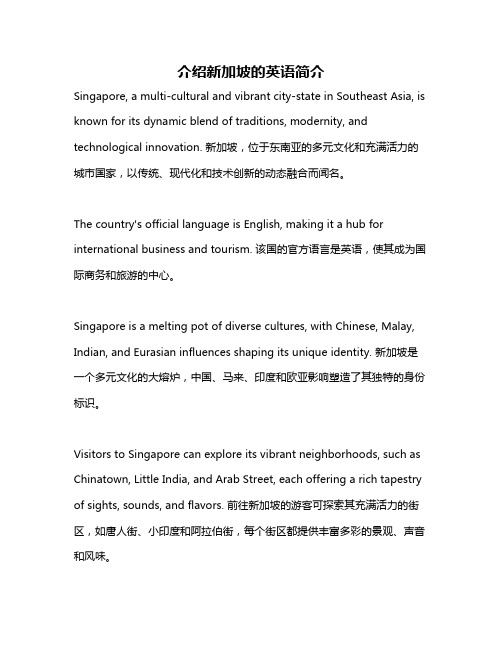
介绍新加坡的英语简介Singapore, a multi-cultural and vibrant city-state in Southeast Asia, is known for its dynamic blend of traditions, modernity, and technological innovation. 新加坡,位于东南亚的多元文化和充满活力的城市国家,以传统、现代化和技术创新的动态融合而闻名。
The country's official language is English, making it a hub for international business and tourism. 该国的官方语言是英语,使其成为国际商务和旅游的中心。
Singapore is a melting pot of diverse cultures, with Chinese, Malay, Indian, and Eurasian influences shaping its unique identity. 新加坡是一个多元文化的大熔炉,中国、马来、印度和欧亚影响塑造了其独特的身份标识。
Visitors to Singapore can explore its vibrant neighborhoods, such as Chinatown, Little India, and Arab Street, each offering a rich tapestry of sights, sounds, and flavors. 前往新加坡的游客可探索其充满活力的街区,如唐人街、小印度和阿拉伯街,每个街区都提供丰富多彩的景观、声音和风味。
In addition to its cultural diversity, Singapore is renowned for its efficient public transportation system, clean streets, and lush green spaces. 除了其文化多样性外,新加坡还因其高效的公共交通系统、清洁的街道和郁郁葱葱的绿地而闻名。
新加坡风俗文化英语简介

Republic of SingaporeDiwaliSpecial Singapore festivalDiwali or Deepavali, popularly known as the "festival of lights," is a festival celebrated between mid-October and mid-December for different reasons.For Hindus, Diwali is one of the most important festivals of the year and is celebrated in families by performing traditional activities together in their homes.Diwali involves the lighting of small clay lamps filled with oil to show the triumph of good over evil.These lamps are kept on during the night and one's house is cleaned, both done in order to make the goddess Lakshmi feel welcome. Firecrackers are burst in order to drive away evil spirits.During Diwali, all the celebrants wear new clothes and share sweets and snacks with family members and friends.Vesak is a holiday observed traditionally by Buddhists in many countries,suchas :Bangladesh, India, Nepal, Sri Lanka, and the South East Asian countries of Singapore, Vietnam, Thailand, Cambodia, Laos, Malaysia, Burma, and Indonesia.Sometimes informally called "Buddha's Birthday", it actually encompasses the birth, enlightenment and passing away of Gautama Buddha.The exact date of Vesak varies according to the various lunar calendars used in different traditions. Everyyear ,on the 15th day of the fourth lunar month the festival is celebrated in Singapore .3.Social Etiquette4.tour5.Major taboo1.dressing2.sitting and standing postureThe Etiquette( 礼节) and CustomIt is summer in Singapore almost all the year around .Their clothing is simple and comfortable in daily life ,men usually wear T-shirts,and women wear skirts ,or T-shirts,jeans.Both of them prefer sandals than leather shoes.But formal clothes are necessary on formal occasions,such as a good suit or tie .it's impolite to wear casually in a formaloccasion.Their traditioal dressing is Nyonya (娘惹) clothing.They seldom separate their feet when they are sitting .Sometimes ,they cross their legs and put one knee on the other.When they are standing , they never place hands on their hips ,because it is a sign of anger.Most of the local businessmen speak English.And business cards are exchanged when they meet each other, the cards can be printed in English.Not to smoke as far as possible when there is a meeting.Singaporean don't like extravagance, or parading their wealth.Tips are forbidden to ask , even extra services .If you tip thewaiter,you will be refused.Major taboo:Singaporean don't like number 7 , and the tortoises. Setting off fireworks is forbidden.•They don't like black and purple ,specially Spring Festival Period.Because they think black and purple will bring bad luck,and they are the colour of evil .Red , blue or green is welcomed,red stands for dignity,enthusiasm,coura ge .。
新加坡英语语音特点探析
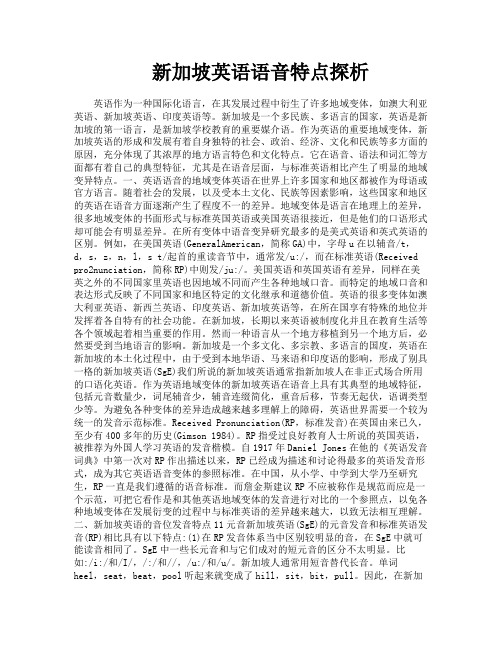
新加坡英语语音特点探析英语作为一种国际化语言,在其发展过程中衍生了许多地域变体,如澳大利亚英语、新加坡英语、印度英语等。
新加坡是一个多民族、多语言的国家,英语是新加坡的第一语言,是新加坡学校教育的重要媒介语。
作为英语的重要地域变体,新加坡英语的形成和发展有着自身独特的社会、政治、经济、文化和民族等多方面的原因,充分体现了其浓厚的地方语言特色和文化特点。
它在语音、语法和词汇等方面都有着自己的典型特征,尤其是在语音层面,与标准英语相比产生了明显的地域变异特点。
一、英语语音的地域变体英语在世界上许多国家和地区都被作为母语或官方语言。
随着社会的发展,以及受本土文化、民族等因素影响,这些国家和地区的英语在语音方面逐渐产生了程度不一的差异。
地域变体是语言在地理上的差异,很多地域变体的书面形式与标准英国英语或美国英语很接近,但是他们的口语形式却可能会有明显差异。
在所有变体中语音变异研究最多的是美式英语和英式英语的区别。
例如,在美国英语(GeneralAmerican,简称GA)中,字母u在以辅音/t,d,s,z,n,l,s t/起首的重读音节中,通常发/u:/,而在标准英语(Received pro2nunciation,简称RP)中则发/ju:/。
美国英语和英国英语有差异,同样在美英之外的不同国家里英语也因地域不同而产生各种地域口音。
而特定的地域口音和表达形式反映了不同国家和地区特定的文化继承和道德价值。
英语的很多变体如澳大利亚英语、新西兰英语、印度英语、新加坡英语等,在所在国享有特殊的地位并发挥着各自特有的社会功能。
在新加坡,长期以来英语被制度化并且在教育生活等各个领域起着相当重要的作用。
然而一种语言从一个地方移植到另一个地方后,必然要受到当地语言的影响。
新加坡是一个多文化、多宗教、多语言的国度,英语在新加坡的本土化过程中,由于受到本地华语、马来语和印度语的影响,形成了别具一格的新加坡英语(SgE)我们所说的新加坡英语通常指新加坡人在非正式场合所用的口语化英语。
新加坡繁荣都市的多元文化
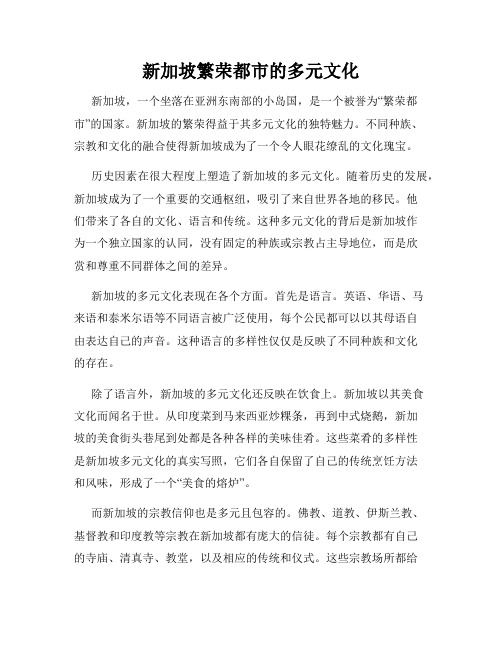
新加坡繁荣都市的多元文化新加坡,一个坐落在亚洲东南部的小岛国,是一个被誉为“繁荣都市”的国家。
新加坡的繁荣得益于其多元文化的独特魅力。
不同种族、宗教和文化的融合使得新加坡成为了一个令人眼花缭乱的文化瑰宝。
历史因素在很大程度上塑造了新加坡的多元文化。
随着历史的发展,新加坡成为了一个重要的交通枢纽,吸引了来自世界各地的移民。
他们带来了各自的文化、语言和传统。
这种多元文化的背后是新加坡作为一个独立国家的认同,没有固定的种族或宗教占主导地位,而是欣赏和尊重不同群体之间的差异。
新加坡的多元文化表现在各个方面。
首先是语言。
英语、华语、马来语和泰米尔语等不同语言被广泛使用,每个公民都可以以其母语自由表达自己的声音。
这种语言的多样性仅仅是反映了不同种族和文化的存在。
除了语言外,新加坡的多元文化还反映在饮食上。
新加坡以其美食文化而闻名于世。
从印度菜到马来西亚炒粿条,再到中式烧鹅,新加坡的美食街头巷尾到处都是各种各样的美味佳肴。
这些菜肴的多样性是新加坡多元文化的真实写照,它们各自保留了自己的传统烹饪方法和风味,形成了一个“美食的熔炉”。
而新加坡的宗教信仰也是多元且包容的。
佛教、道教、伊斯兰教、基督教和印度教等宗教在新加坡都有庞大的信徒。
每个宗教都有自己的寺庙、清真寺、教堂,以及相应的传统和仪式。
这些宗教场所都给了人们机会去了解和尊重其他宗教信仰,并且促进不同文化之间的交流和友谊。
在新加坡,艺术和文化也扮演着非常重要的角色。
各种音乐、舞蹈、戏剧和电影节目提供了一个平台,让艺术家们可以展示自己的才华和创造力。
无论是中国的京剧,印度舞蹈还是马来舞蹈,每个文化都有机会在新加坡的艺术界发扬光大。
这种文化的多样性不仅丰富了新加坡艺术的内涵,也让艺术成为连接不同文化的桥梁。
新加坡能够实现如此多元的文化融合,并使之和谐共存,有赖于政府的努力。
新加坡政府一直倡导多元文化的发展和保护,并通过立法和政策来确保各种文化的平等地位。
例如,新加坡实施官方种族平等政策,鼓励不同种族之间的交流和交融。
新加坡: 本地华语丰富了“大华语”

新加坡:本地华语丰富了“大华语”【摘要】新加坡是一个多元文化的国家,其中华语拥有重要地位。
随着时间的推移,本地华语逐渐形成了独特的口语表达方式,融合了多种方言特色,形成了所谓的“大华语”。
这种发展受到了广泛关注,许多人对新加坡华语的丰富和发展表示赞赏和关注。
新加坡华语的形成反映了这个国家社会的多元和包容性,为本地文化注入了活力。
新加坡的大华语现象是一个典型的多元文化交融的例子,展现了这个国家独特的文化魅力和包容精神。
【关键词】新加坡、华语、大华语、多元文化、口语表达、方言特色、文化、活力、多元、包容。
1. 引言1.1 新加坡:本地华语丰富了“大华语”新加坡是一个多元文化的国家,这里有来自不同国家和民族的人群,多元文化的融合也促进了多种语言的发展。
在众多语言中,华语在新加坡拥有着重要地位。
随着新加坡的繁荣发展,本地华语逐渐形成了独特的口语表达方式,吸引了越来越多的人关注。
新加坡华语不仅受到普通话的影响,还融合了多种方言特色,如闽南语、粤语、客家话等。
这种多元文化的影响使得新加坡华语具有了更广泛的表达方式,丰富了它的表现力和独特性。
新加坡的华语也被称为“大华语”。
2. 正文2.1 新加坡是一个多元文化的国家新加坡是一个多元文化的国家,这一点从其独特的社会构成和丰富多彩的文化传统就可以看出。
新加坡的居民来自不同的种族和文化背景,主要包括华人、马来人、印度人和其他少数民族,这种多元文化的特点在新加坡的华语社区中尤为突出。
新加坡的多元文化给华语社区带来了丰富的语言资源,不仅华人社区使用汉语,马来人社区使用马来语,印度人社区使用泰米尔语,而且还有其他少数民族使用他们的母语。
这样的语言多样性不仅丰富了新加坡的语言环境,也为不同族群之间的交流和融合提供了重要的基础。
除了种族和文化多样性外,新加坡还是一个经济繁荣、国际化程度高的城市,吸引了大量外国人前来就业和定居。
这些外国人带来了各种不同的语言和文化,丰富了新加坡的语言环境,也促进了本地华语的发展和演变。
新加坡的英语

新加坡的英语新加坡的英语,也被称为“新加坡英语”或简称为“SGE”,是新加坡的官方语言之一。
作为国家的官方语言之一,英语在新加坡的教育、政府和商业领域中起着重要的作用。
下面将介绍一些关于新加坡英语的背景、特点和使用情况。
新加坡英语起源于英国殖民时期,它是在19世纪末20世纪初的波利说法(Bazaar Malay)基础上形成的。
波利说法是在新加坡当地和马来族之间使用的商业和交流语言,它融合了马来语、华语、泰语和其他南亚语言的元素。
随着英国殖民地教育系统的发展,英语逐渐成为新加坡的官方语言。
新加坡英语的特点受到了多种语言的影响。
它的词汇和语法结构主要受到英语的影响,但也借用了许多马来语、华语和其他南亚语言的词汇和表达方式。
这些综合了多种语言元素的特点,使得新加坡英语有时被称为“罗嗦英语”(Singlish)。
除了词汇和语法上的差异,新加坡英语的口音和语调也有所不同,常常带有南亚和马来语的独特音调。
新加坡英语在新加坡的社交、工作和教育环境中得到广泛使用。
在社交场合中,人们经常使用新加坡英语进行对话,这也是新加坡社会的一种独特特征。
在工作场所,英语被认为是正式交流的语言,特别是在跨文化和跨国公司中。
另外,英语在新加坡的教育系统中也占有重要地位,学校的主要授课语言是英语。
然而,新加坡的英语也受到了一些争议和批评。
一些人认为新加坡英语的使用给新加坡的英语教育带来了挑战,因为新加坡英语和标准英语之间存在一些差异,这可能会影响学生的英语学习。
此外,新加坡英语有时也被视为非正式和低级的语言,被一些人认为是不正确的英语使用。
尽管存在争议,但新加坡英语仍然是新加坡社会中不可分割的一部分。
它反映了新加坡作为一个多元文化社会的特点,展示了不同族群和文化之间的融合和交流。
同时,新加坡英语也是推动新加坡教育、商业和国际交流的重要工具。
总结来说,新加坡英语是新加坡的官方语言之一,起源于英国殖民时期,融合了英语、马来语、华语和其他南亚语言的特点。
- 1、下载文档前请自行甄别文档内容的完整性,平台不提供额外的编辑、内容补充、找答案等附加服务。
- 2、"仅部分预览"的文档,不可在线预览部分如存在完整性等问题,可反馈申请退款(可完整预览的文档不适用该条件!)。
- 3、如文档侵犯您的权益,请联系客服反馈,我们会尽快为您处理(人工客服工作时间:9:00-18:30)。
Language in SingaporeThe four official languages of Singapore are Mandarin, Malay, Tamil and English. English is themost common language used and is the language which unites the different ethnic groups.Children are taught in English at school but also learn their mother tongue to make sure they don't lose contact with their traditions.Expatriates and foreigners may encounter language problems in the beginning of their stay inSingapore as many Singaporeans use Singlish to communicate. Singlish is a mix of English withother languages mixed into the English, sometimes phrases can end with funny terms like 'lah','leh', mah'. Chinese commonly use their own dialects to communicate, and sometimes,inter-dialect groups don't understand one another's language, as the language is vastly different.Except for Hokkien and Teochew, which have a closer link. The Malays use the language amongtheir fellow races and the Indians speak Tamil. But whatever the race or religion, the country'scommunity unite as one nation, where most religious or racial gaps are being bridged.Singapore English has its origins in the schools of colonial Singapore. In the nineteenth centuryvery few children went to school at all, and even fewer were educated in English. The people who spoke English and sent their children to English medium schools were mainly the Europeans, the Eurasians (people of mixed racial ancestry), some of the small minorities, such as the Jews, some of the Indians and Ceylonese, and also a group of Chinese people usually called the Straits Chinese, who had ancestors of long residence in the region, and who spoke a variety of Malay usually called Baba Malay which was influenced by Hokkien Chinese and by Bazaar Malay.The fact that all these children would have known Malay probably explains why most of the loan words in Singapore Colloquial English are from Malay. The largest group of teachers wereEurasians, and there were also many teachers from Ceylon and India. European teachers werenever more than a quarter of the total teaching staff in a school, and they usually taught the senior classes. These Europeans may have been from Britain (which at that time included Ireland) butwere also from the USA, Belgium and France. The children in these schools would have beenexposed to many varieties of English.In the first twenty years of the twentieth century, English medium education became popular for all groups. Girls started going to school in larger numbers too. By the 1950s nearly all children went to school, and the majority were educated in English. By the 1980s. all education was in themedium of English (with children learning another language alongside English).Singapore English grew out of the English of the playground of these children of various linguistic backgrounds who were learning English at school. As more and more of its people experienced learning English at school, English became widely spoken, alongside Singapore's many other languages. Since Singapore became an independent Republic in 1965, the use of English has increased still further. For many Singaporeans, English is the main language. Many families speak English at home and it is one of the the first languages learnt by about half of the current pre-school children.Nearly everyone in Singapore speaks more than one language, with many people speaking three or four. Most children grow up bilingual from infancy and learn more languages as they grow up. Naturally the presence of other languages (especially various varieties of Malay and of Chinese) has influenced the English of Singapore. The influence is especially apparent in the kind of English that is used informally, which is popularly called Singlish. Singlish is a badge of identity for many Singaporeans.SinglishSingapore English usually come from other languages spoken in Singapore, especially Malay and Hokkien. Speakers of Singlish are not necessarily aware of which language they are from however.Example:∙habis - finished∙makan - to eat∙chope - to reserve something∙cheem - difficult, complicated∙ang mo - a white person∙rojak - mixed, a mix of∙liao - finished, the end∙kiasu - afraid to lose mentalitySpeakers of Singlish will usually end his sentence with a distinctive exclamation. The three most common are ah, lah, ley and what.Examples:∙OK lah, bye bye.∙Don't like that lah.∙You are going there ah?∙No parking lots here, what.∙The price is too high for me lah.∙And then how many rooms ah?∙It is very troublesome ley.∙Don't be like that ley!I'm not at home lah. That's why ah.。
